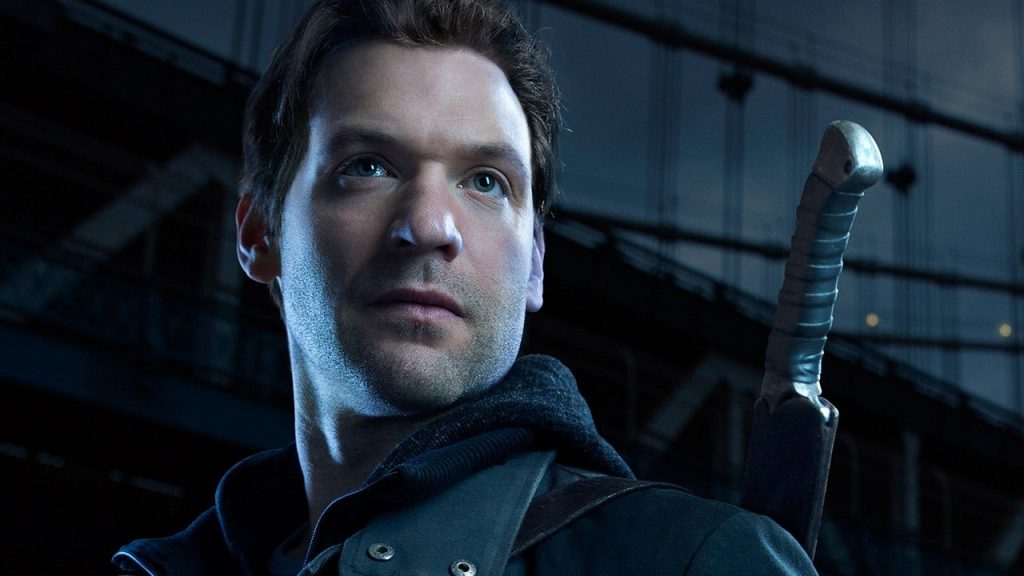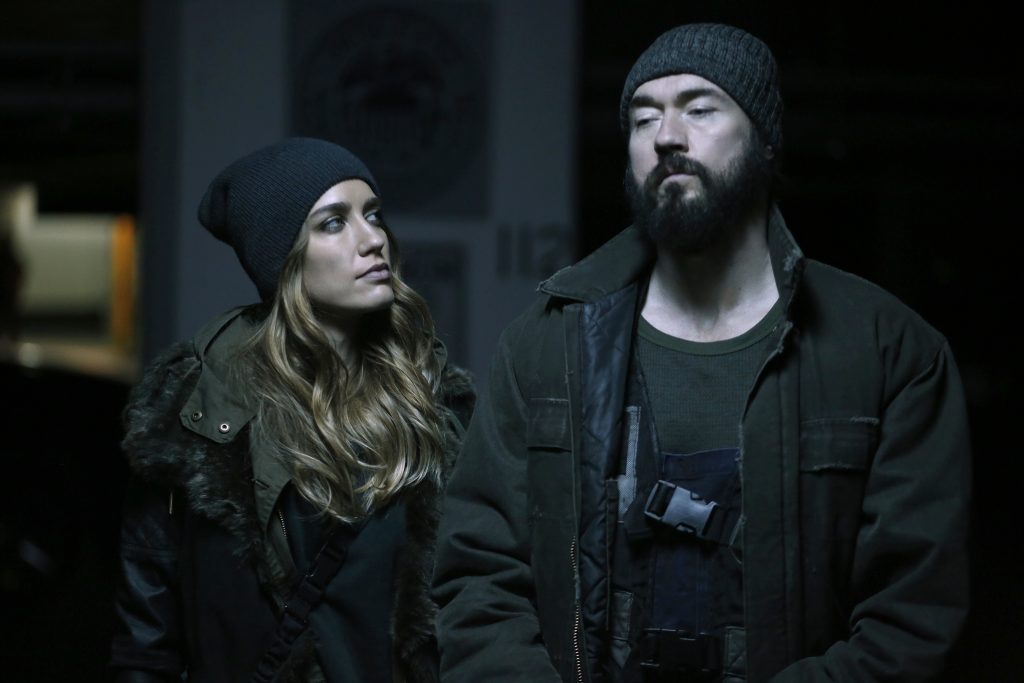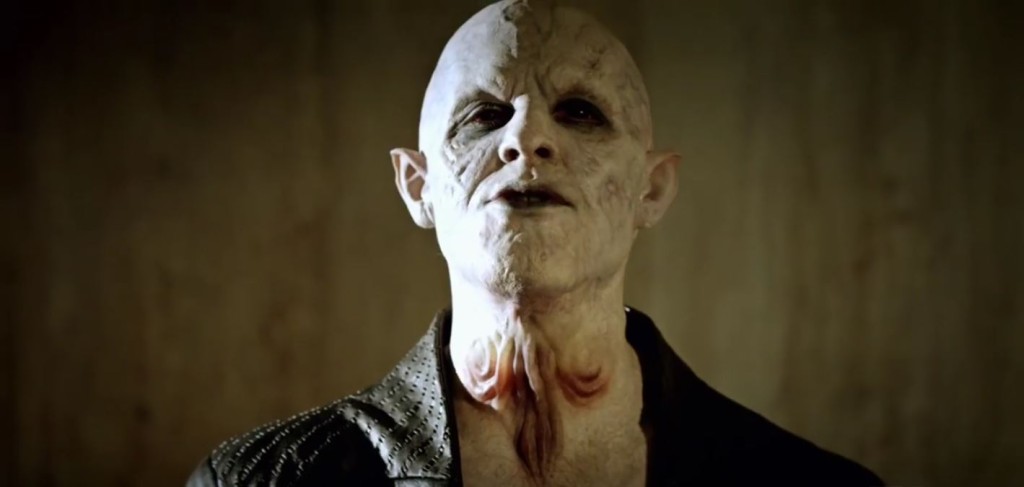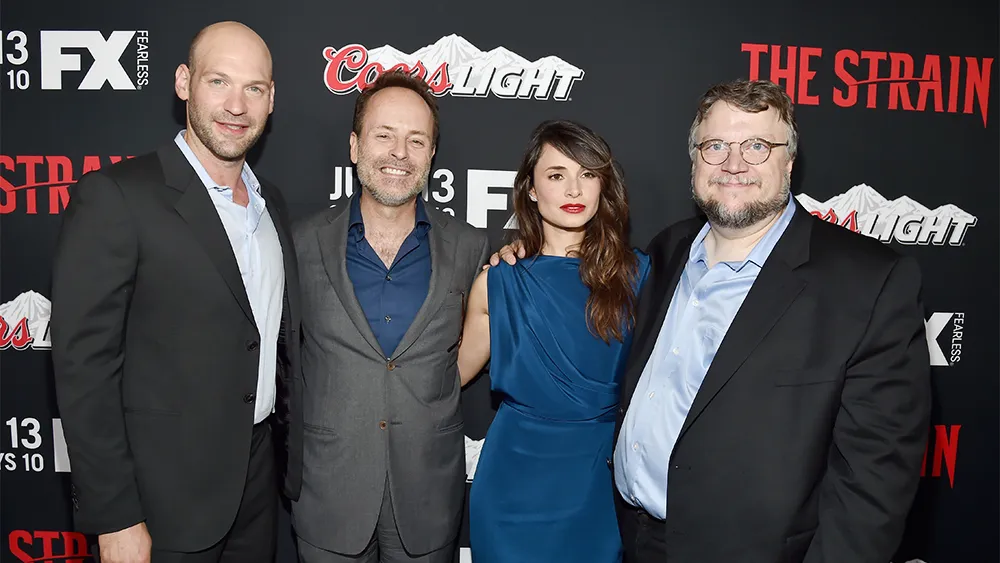This article by current editor Jennifer Griffin originally appeared in ScreenSpy Magazine (the online publication she created and directed for over 12 years), on July 12, 2014.
New vampire series The Strain premieres this Sunday July 13 on FX, and it’s as scary as all hell.
The series looks likely to send a shockwave through a TV landscape currently saturated with vamps who are handsome romantic heroes and love interests.
ScreenSpy sat down with series creators and executive producers Guillermo del Toro (Pacific Rim, Pan’s Labyrinth) and Carlton Cuse (Lost, Bates Motel) this week to discuss the series’ source material, the complicated process of creature creation, finding the right cast for the project and more.
Read on for highlights from our interview below.
What drew you to this material?
Carlton Cuse: I had read the first Strain novel as a fan of both Guillermo’s work, and also independently I knew Chuck Hogan, and so I was very curious to see what this collaboration would look like. And I was just intrigued by the subject matter. I had read the first novel when it came out in 2009 and really enjoyed it, and then basically about two years ago my agent called me up and said that there was some interest in doing The Strain as a television series and would I be interested in it. And I went and met with Guillermo and I had a really good meeting, and I basically decided to get involved, for two reasons. One, because I had a lot of respect for Guillermo as a filmmaker and I thought, particularly in a monster show like this, that he’s one of the most imaginative guys out there in terms of creating creatures and worlds. And I also thought that embedded in the book was this fantastic opportunity to upend the vampire genre, as the vampire genre has sort of been overrun by romance, and that we had had our fill of vampires that we’re feeling sorry for because they had romantic problems. And it was time to go back to the conception of vampires as really scary, dangerous creatures, and in so doing that there was a way to kind of make a genre show that would be different than anything that was out there on the TV landscape.
How closely will the TV series follow the source material?
Carlton Cuse: Book one is season one. We basically follow the narrative of the first book in the first season. The plan is that the show will run somewhere between three and five seasons, and as we work out the mythology and the storytelling for season two we’ll have a better idea of exactly how long our journey is going to be. But it won’t be more than five seasons, we’re definitely writing to an endpoint, and we’re following the path as established in Guillermo and Chuck’s novels.
But obviously there’s a lot that’s also going to be added. The television show is its own experience, and there are new characters and new situations, different dramatic developments, so the show and the book can each be separately enjoyed. And I think that the goal is not to literally translate the book into a television show. You want to take the book as a source of inspiration and then make the best possible television show that you can make. And I think Guillermo, Chuck, myself, all of us involved have basically said, okay, here’s the book, now how do we take the best stuff in here and then use that as elements and then make the best TV show we can. But we view the TV show as its own creation.
Guillermo del Toro: It was very clear from the start that we had the three books to plunder, but we also had the chance of inventing. We talked about milestones, that we want the milestones and the characters that are in the book to be hit, but with that it became very malleable. Carlton decided, I think very wisely in retrospect, it made perfect sense as a game plan to, for example, leave the origins of The Master, which we opened book one with for a second season, if we go that way, and, for example, bringing a set piece from book two to bookend the story of one character on season one. So, it’s a very elastic relationship that the series has with the book, but by that same token it’s very respectful and mindful of the things that will not alienate someone that likes the books. It should feel as seamless. And I think the decisions we have to understand when Carlton is guiding us through this new medium for the story, to trust and know that his decisions are guided by huge experience and a prestigious career.

Pictured: Corey Stoll as Ephraim Goodweather. CR. Michael Gibson/FX
What is it about the horror genre that attracts so many people?
Guillermo del Toro: From my end what I think is very apparent is that we’ve come to the point where socially, as we are mammalian creatures we are territorial, we are built to fight and fend off territorial challenges, reproduce, and sit a sedentary life, you know, ultimately that’s the way we’re socially and animalistically geared, and yet we live in a society that the more it isolates itself from its natural instincts, the more it seeks them in entertainment. And I think there is a vicarious thrill your brain needs, the way your body needs the exercise in a way, your brain needs to be exposed to flight and fight instincts, and you seek it through a roller coaster, or some people seek it through extreme sports, or you can seek it in genres like noir crime, horror, adventure, etc. It’s literally a biochemical mammalian biofeedback with how we are constructed to organize the storytelling in our lives, I think.
Carlton Cuse: I completely agree with everything that Guillermo said, although I don’t discount that some reptiles will also like the show!
Talk to me a little bit about the creature creation side of things.
Guillermo del Toro: In terms of creature creation we really went into it trying to, little by little, reveal the biological traits and the design traits of these creatures to make sense to an audience, not just from a looking terrifying, looking good point of view, but to make them feel organic, to make them feel like almost a different breed in the evolutionary history of this planet. You get to see them as a species, in a way, the more you advance in the plot and in this series.
So, designing it took approximately six months of just purely conceptual and sculpture and draftsmanship design, and executing it took a very long, long time. But it was as complex and as demanding as designing creatures for a feature film. I’ve been obsessed by vampires for a long, long time, since I was a very young kid, and a very strange kid. I read about vampire mythology worldwide and I familiarized myself with the Japanese, Filipino, Malaysian, and Eastern European variations on the vampire, and many, many others. And I kept very detailed notes as a kid on where to go with the vampire myth in terms of brutality, social structure, biology, this and that, and some of those notes made it into my first feature, Cronos, some of them made it in Blade II, when I directed that, and most of them made it into The Strain.
And designing them, we knew and we had it very clear that, for example, The Master needed to be hidden for at least half the season or more to not make him that accessible.

And I came up with the idea that this guy that has been alive for centuries and essentially is an apex of the Dark Ages in the middle of a world of imminent modernity. You have people with cell phones, jet airplanes, iPads, texting, Internet, all of that, and in the middle of it there is a 9 foot tall, hand carved coffin with a creature that has been alive for centuries.
And it’s ancient, and that’s what makes it powerful, that it doesn’t care about any of the modern accoutrements of mankind that gives mankind such a false sense of security. And The Master needed to look that ancient, so we decided that he was going to become his wardrobe and that eventually when he reveals himself you have a second layer. So we designed the wardrobe, the cape and the multiple layers of clothes that are falling apart, because he has an accumulation of clothes over the 1800s, 1900s, 21st century, he’s just accumulating rags, and he needed to look like a lump, like a bunch of rags thrown on the floor, then come alive, and out of all these rags comes out this incredibly glistening and viscerally biological appendage that then drains the first victim. And that’s the way we started guiding the process of designing The Master.
And the more we go into the season, the more you see of him and the more you discover layer after layer of that creature design. I knew that the older the vampires stay alive, the older that they stay alive, the more they lose their humanity. They start literally by losing their heart. Their heart is suffocated by a vampire heart that overtakes the functions. And this was important metaphorically for me because the beacon that guides these vampires to their victims is love. Love is what makes them seek their victims. They go to the people they love the most. So they turn their instinct that is most innately human into the most inhuman feeding mechanism, so their heart is dead. Then shortly thereafter their digestive system is overtaken. Then, as we do in an early episode, their genitals fall off. And their excretion system becomes really, really efficient in the way that ticks, or lower forms of life that feed on blood do, a tick in order to feed needs to eliquate itself, and they are eliquating while they are feeding. And in the series that comes with the big splashes of ammonia infused liquid that they expel while they’re feeding. And then I know that they lose their soft tissue, their ears start falling off, their nose, if they’ve been alive for several years their nose rots and falls away, and they develop a tracheal opening to vent the extra heat from the metabolism and to project the stinger. So, I take a very biological approach. It’s not just, oh, that looks cool. I try to have it make sense biologically in the design.

CR. Michael Gibson/FX
How did you find the right cast for a project like The Strain?
Carlton Cuse: Guillermo and I cast the entire show together over almost a year. And again, it was another one of those advantages of having a lot of time to prep the show. We had a lot of time to thoughtfully consider who was going to be in our cast. Also we have to give a lot of credit to the wonderful April Webster, our casting director, she cast Lost, and she came and did our show. And she has wonderful taste and a wonderful ability to find actors. We met a lot of actors and we spent a lot of time discussing and considering who would be right for these roles, and as I said, we did it thoughtfully over a long period of time. And it’s just a hugely important part of the process.
The longer I’ve done television—I used to have a lot more hubris about the power of writing, you know that it would conquer all, but I don’t anymore. I really think that as good a job as you do as a writer, you’re absolutely indebted to the actors that have to deliver that material. And we were incredibly fortunate to get some wonderful name actors like Corey Stoll, but to also find some amazing discoveries like Miguel Gomez and Richard Sammel.
Guillermo del Toro: Yes. I think that we have a great collaboration with April, and we cast everything together. Literally we had sessions of casting in the same office, and in the case of at least two or three of the parts we basically didn’t cast a wide net, we knew who we wanted, and when meeting the actors proceeded to offer them the role right there on the first meeting. And it happened again and again. We saw the casting as a mixture of going for the unexpected.
Or, like in the case of Sean Astin, we said I think his character and the turn of his character is really feeding on his persona and his baggage in a great way, he’s so reliable, so adorable, and his character has to do things that are ambivalent.
In the case of Corey, and almost more cases than I have ever seen in a project, we were completely in sync in the casting.
The Strain stars Corey Stoll, Mia Maestro, Sean Astin, Kevin Durand, Natalie Brown, Jonathan Hyde Richard Sammel, Robert Maillet, Jack Kesy, Ben Hyland, Miguel Gomez and David Bradley, and premieres Sunday July 13 on FX.

